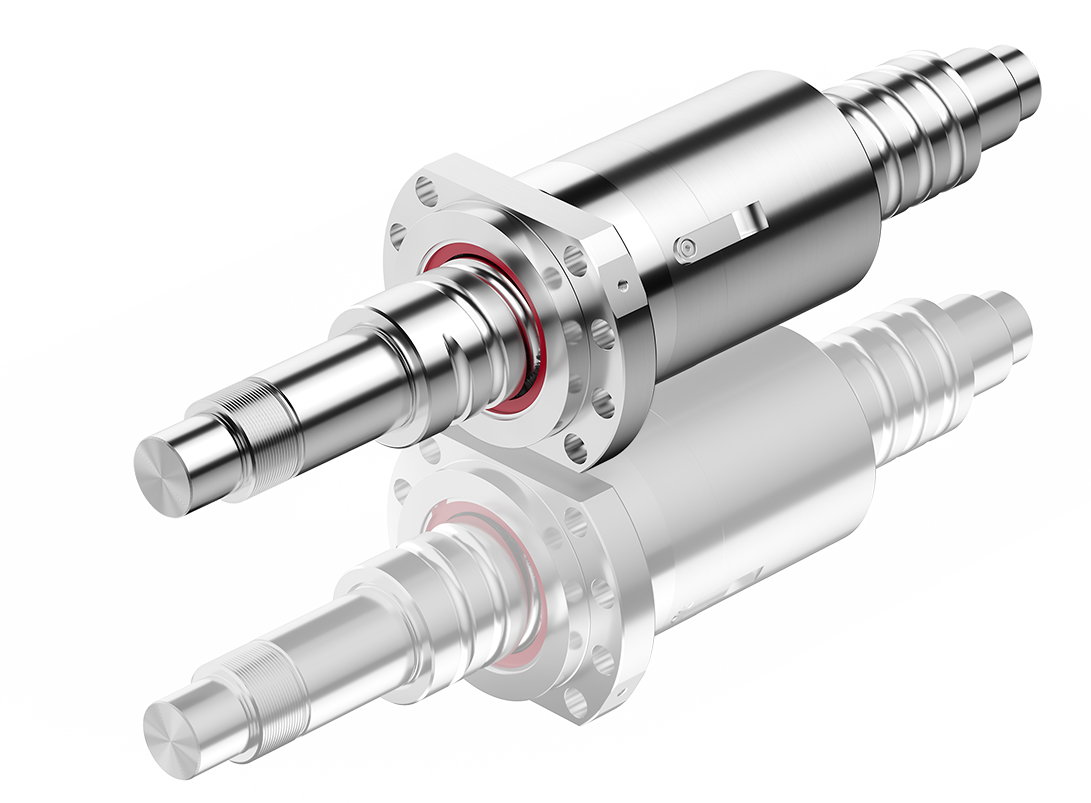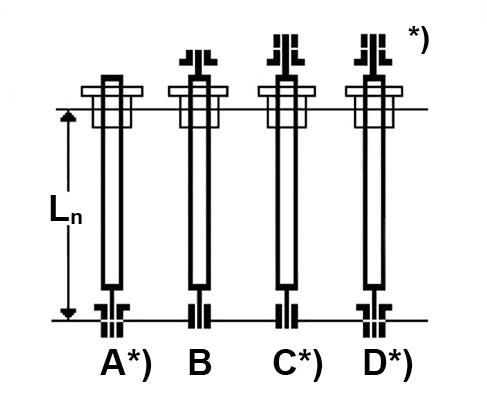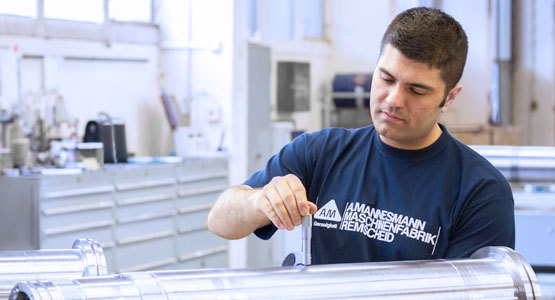Overview of SCHNEEBERGER Ball Screws SBS with Driven Ballscrew shafts
ground positioning ball screws are mainly used in highly demanding applications such as machine tool or measuring and testing machines. The precision ground ball contact surfaces deliver high positioning and repeat accuracy. This means, the path distance can be measured via the spindle. Furthermore these ball screws operate smoothly and hold constant torque.

SCHNEEBERGER Ball screw SBS
High Flexibility in Application
The nut as well as the spindle can travel with ball screws with driven spindles. They are equally well-suited for horizontal and vertical installation.
Areas of application for ground ball screws
- Machine tools
- Process machines
- General mechanical engineering
- Robotics and automation
- Drive technology
- Plastic injection molding machines
- Measuring and testing technology
Technical advantages
- Driven spindle
- Critical bending speed determines the application limits (speed characteristic value of dn x n (nominal diameter x speed) < 200,000)
- High precision and efficiency
- Very long service life
- High nut rigidity
- Low friction
- Low idle torque
- The highest power transmission rates
- Extremely high degree of efficiency (up to 98%)
Driven screws can either be driven directly
Driven screws can either be driven directly via a coupling or a belt drive or can be driven indirectly by a motor. They are usually mounted in suitable ball bearings on one side or on both sides. In order to achieve a powerful drive unit, the performance characteristics of the bearings and the ball screw must be coordinated. The spindle length individually depends on the desired travel of the user and the nut length.
If the ball screw nut is firmly connected with the machine assembly to be moved, then they move together in an axial direction when the spindle rotates. The displacement speed is determined by the thread pitch and the spindle speed. The displacement direction depends on the rotational direction of the ball screw spindle and the pitch direction of the thread (right or left). With short spindles, the acceleration capacity of the balls limits the maximum operating speed, especially in the ball return area. On the other hand, the limitation of the maximum displacement speed for long spindles usually occurs through the critical bending speed of the spindle and the avoidance of resonance phenomena.
Since the nut stands still and does not rotate with driven spindles, the lubricant supply usually easily occurs via the mounting flange. It is also very easy to realize the nut cooling or a sensor monitoring of the operating state.
Spindle Bearing Options
The ends of rotating spindles are accommodated in suitable bearings in order to dissipate the axial forces into the machine environment. Both ball and roller bearings can be used here. Ball bearings can transmit higher speeds than roller bearings, but roller bearings have a higher load capacity. In addition to the axial forces of the ball screw, the bearings may also need to absorb the radial forces from the drive system (e.g. belt drive). The axial load rating of the bearing system must be slightly larger than that of the ball screw so that the load and therefore the service life of the bearings to be expected corresponds to that of the ball screw.
A distinction is made with this type of bearing between fixed and floating bearings. The fixed bearing forms the axial anchor point of the ball screw and transmits all forces that may act in the axial and radial direction. Unlike the fixed bearing, the floating bearing can be displaced for axial compensation and can therefore not transmit any axial forces, but rather only radial forces.
Depending on the spindle length, the bearing of a ball screw spindle can occur on one side or both sides. Due to the distribution of forces, a one-sided spindle bearing must always be designed as a fixed bearing. With bearing on both sides, a combination of fixed and floating bearings is usually used. It is also possible to combine two fixed bearings, whereby the thermal expansion of the spindle and the associated additional axial load on the bearing absolutely must be taken into consideration. The selection of the bearing type and the bearing size depends on the load and the spindle speed. In most application cases, the standardized bearings offered by different bearing manufacturers can be used for ball screws. For higher loads and requirements, however, custom bearing designs may be necessary and useful. The type of bearing and the number of bearing points affect the axial rigidity, the buckling resistance, the critical bending speed and therefore the applicability of the ball screw. Attention is therefore in particular to be paid to the angular stability of the spindle pivot in the bearing when it comes to the bearing design.
Degree of Slenderness Influencing Factor
The degree of slenderness of a ball screw spindle is the ratio of spindle length to diameter (l/d). Spindles with a degree of slenderness > 40 are referred to as long spindles. The vibration and running behavior of the ball screw spindles deteriorates with an increasing degree of slenderness. So that the shear force load on the ball screw from the spindle's own weight does not get too large and the geometrically stable ball run remains ensured, the unavoidable slack with spindles must be compensated for with a degree of slenderness of > 50. For this purpose, for example, the user must use towing steady rests arranged on both sides or similarly suitable supports (e.g. support bushings). Otherwise there is the risk of early wear and the associated increased positioning inaccuracy due to radial forces and edge carriers.
Spindle Drive Directly or via Gearbox
The power of the motor can be introduced directly into the spindle via a torsionally rigid coupling or an upstream gearbox. The gearbox reduces the engine speed, thereby increasing the usable torque with the same drive power. If the motor would be too large due to excessively high drive power and dynamics would thereby be lost, both spindle ends can also be driven by a motor each. However, in order to not obtain any additional torsional load in the spindle, both motors must operate absolutely synchronously through the machine control. The control system manufacturer offers special operating modes (e.g. master-slave operation or gantry operation) with a very high level of uniformity and control quality for this very purpose.
Manufacturing Restrictions
Driven spindles have a restricted manufacturing length or usable application length depending on their diameter. The manufacturing length is determined by the maximum possible thread grinding length or by the availability of the starting material. The application length depends on the structural design.
Critical Bending Speed
The dynamic application limits for precision ball screws with driven spindles are determined by the critical bending speed or the mass forces acting on the balls during operation.
The speed characteristic value of dn x n (nominal diameter x speed) < 200,000 applies as a reference value for precision ball screws from A.MANNESMANN with driven spindles.
Characteristic Values of the Ball Screws
In addition to the dimensions, the load ratings, the nut rigidity and the idle torque are the classifying characteristic values of ball screws. The load ratings describe the load bearing capacities of the ball screw during movement (dynamic) and at rest (static). The dynamic load rating is also the basis for calculating the service life.
The nut rigidity is the measure for the axial force, which is required for deformation in the ball transition contact. The idle torque is the characteristic value for the internal system friction. Together with the nut rigidity, the preload can also be closed via the idle torque.
You will find the characteristic values in the technical data sheet of each ball screw.
Rotatory Mass Moment of Inertia
The rotatory mass moment of inertia (Js) of the spindle is usually required for designing the motor. With driven solid spindles, this (with a good approximation neglecting the thread geometry) corresponds to the cylindrical spindle body with respect to its axis of rotation.
Here the ball contact diameter dc on the spindle with the 4th power, the spindle length ls and the density of the spindle material rs are decisive. The mass moment of inertia Js is usually specified in kgcm2. If the rotatory mass moment of inertia Js is related to the spindle length of one meter, then it can easily be converted by multiplying the ratio of the existing spindle length with one meter.
Spindle Torsion
The spindle is normally driven by a motor. The motor's drive torque is guided through the spindle to the nut and there converts into an axial force. In the slim spindle, this results in a torsion due to the torsional moment that exists. The torsion length, the torsion angle and therefore also the torsional rigidity depend on the axial nut position on the spindle. Since this can change variably in operation due to the axial displacement, the torsional rigidity is also not a constant characteristic value.
The maximum torsional stress of the spindle (can usually also be assumed to be a circular full cross-section) can be determined from the torsional moment or torque (T) and from the polar modulus of resistance of the ball screw spindle (Wps) or the spindle diameter.
The torsion angle (torsional angle) is dependent on the spindle length or on the position (I) where the torque acts and on the shear modulus (G) of the spindle material. To calculate the torsional angle, the moment of area of the 2nd order (Ips) and the torsional moment (T) are also required.
Since the effective position (I) varies depending on the axial travel movement of the nut, the torsional angle (j) is also not a constant value, but rather is a function of the length (I). However, torsional angle is also directly dependent on the time variation of the effective torque, whereby it is also to be seen as a function of time. That is why torsional vibrations that temporally vary depending on the torsion are created, which also act in the axial direction through the ball screw.
Tensile and Compressive Load
In addition to the torsional load, a driven spindle is mainly loaded by tension or pressure. In both cases, the tensile or compressive strength of the spindle are the load limit values.
When evaluating the load, it is important to take the correct "smallest" spindle cross section into account. Only the cross-section that lies in the spindle's distribution of forces is relevant for determining the tension. With the tensile load, the determining spindle cross section usually does not lie in the area of the ball screw, but rather in the area of the mounting thread of the bearings. The buckling stability is also to be noted, since there is a risk of buckling in the event of a compressive load on particularly long spindles.
Characteristic Value Calculations
As part of our service, we offer you the calculation of the most important characteristic values. We would like to support you in your planning from an early stage.
Get in touch with us by sending an e-mail to salesamannesmannde with the subject "Characteristic value calculation" or by phoning us at +49 2191 989-0 and give us the following parameters of your desired ball screw:
- Nominal diameter d0 [mm]
- Pitch P [mm]
- Ball diameter DK [mm]
- Spindle length Ln [mm]
- Bearing selection: Bearing A, bearing B, bearing C, bearing D

*) Directionally stable clamping
Direct to our service
Your request to us
Use our professional competence to develop the best solution. Our engineers can be reached directly under
+49 2191 989-200
Downloads
In our Download Center, you will find all of the information that we provide you as files for downloading, arranged by category.
Downloads for this Product

ball screws folder 8.94 MB

Ball_screws_Precision_ground_new 0.99 MB

characteristics ball screws 16.00 KB

company profile 478 KB

enquiry ball screws 1.90 MB

telescopic ball screws 7.80 MB

Zertifikat_DIN_EN_ISO_9001 1.49 MB
Direct to our service
Your request to us
Use our professional competence to develop the best solution. Our engineers can be reached directly under
+49 2191 989-200


